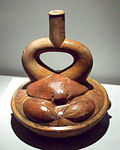Crab
- For other uses, see Crab (disambiguation).
| Crabs | ||||||||||||||
|---|---|---|---|---|---|---|---|---|---|---|---|---|---|---|
 Callinectes sapidus
|
||||||||||||||
| Scientific classification | ||||||||||||||
|
||||||||||||||
| Superfamilies | ||||||||||||||
|
Crabs are decapod crustaceans of the infraorder Brachyura, which typically have a very short projecting "tail" (Greek: βραχύ/brachy = short, ουρά/οura = tail), or where the reduced abdomen is entirely hidden under the thorax. They are generally covered with a thick exoskeleton, and armed with a single pair of chelae (claws). 6,793 species are known.[1] Crabs are found in all of the world's oceans. Additionally, there are also many freshwater and terrestrial crabs, particularly in tropical regions. Crabs vary in size from the pea crab, only a few millimetres wide, to the Japanese spider crab, with a leg span of up to 4 m.[2]
Contents |
Diet
Crabs are decapods—ten-legged omnivores—but the front pair of legs are specialised with enlarged claws, so they are often described as eight-legged. Some species feed primarily on algae, while others take any type of food, including mollusks, worms, other crustaceans, fungi, bacteria, and detritus, depending on availability and on the species of crab. For many species, a mixed diet of plant and animal matter results in the fastest growth and greatest fitness.
Crab Fishery

Crabs make up 20% of all marine crustaceans caught and farmed worldwide, with over 1½ million tonnes being consumed annually. Of that total, one species accounts for one fifth: Portunus trituberculatus. Other important taxa include Portunus pelagicus, several species in the genus Chionoecetes, the blue crab (Callinectes sapidus), Charybdis spp., Cancer pagurus, the Dungeness crab (Cancer magister) and Scylla serrata, each of which provides more than 20,000 tonnes annually [3].
Evolution and classification

The infraorder Brachyura contains about 93 families[4], as many as the remainder of the Decapoda.[5] The evolution of crabs is characterised by an increasing robustness of the body, and a reduction in the abdomen. Although many other groups have also undergone similar processes of carcinisation, it is most advanced in crabs. The telson is no longer functional in crabs, and the uropods are absent, having probably evolved into small devices for holding the reduced abdomen tight against the sternum.[6]
In most decapodes, the gonopores (sexual openings) are found on the legs. However, since crabs use the first two pairs of pleopods (abdominal appendages) for sperm transfer, this arrangement has changed. As the male abdomen evolved into a narrower shape, the gonopores have moved towards the midline, away from the legs, and onto the sternum.[7] A similar change occurred, independently, with the female gonopores. The movement of the female gonopore to the sternum defines the clade Eubrachyura, and the later change in the position of the male gonopore defines the Thoracotremata. It is still a subject of debate whether those crabs where the female, but not male, gonopores are situated on the sternum form a monophyletic group.[5]
The earliest unambiguous crab fossils date from the Jurassic, although the Carboniferous Imocaris, known only from its carapace is thought to be a primitive crab.[8] The radiation of crabs in the Cretaceous and afterwards may be linked either to the break-up of Gondwana or to the concurrent radiation of bony fish, the main predators of crabs.[9]
About 850 species[10] of crab are freshwater or (semi-)terrestrial species; they are found throughout the world's tropical and semi-tropical regions. They were previously thought to be a closely related group, but are now believed to represent at least two distinct lineages, one in the Old World and one in the New World.[11]
Cultural influences of the crab

The Moche people of ancient Peru worshipped nature, especially the sea.[12] They placed emphasis on animals and often depicted crabs in their art.[13]
The Cancer Constellation is one of the 12 Zodiac signs.
Nutrition

Gallery
References
- ↑ Walters, Martin & Johnson, Jinny. The World of Animals. Bath, Somerset: Parragon, 2007.
- ↑ "Biggest, Smallest, Fastest, Deepest: Marine Animal Records". OceanLink. Retrieved on September 22, 2006.
- ↑ "Global Capture Production 1950-2004". FAO. Retrieved on August 26, 2006.
- ↑ Systema Brachyurorum: Part 1. An Annotated checklist of extant Brachyuran crabs of the world Raffles Bulletin of Zoology, 2008, 286pp.
- ↑ 5.0 5.1 Martin, J. W. & G. E. Davis (2001) (PDF). An Updated Classification of the Recent Crustacea. Natural History Museum of Los Angeles County. pp. 132 pp.. http://www.nhm.org/research/publications/CrustaceaClassification.pdf.
- ↑ Guinot, D & J.–M. Bouchard (1998). "Evolution of the abdominal holding systems of brachyuran crabs (Crustacea, Decapoda, Brachyura)" (PDF). Zoosystema 20 (4): 613–694. http://www.mnhn.fr/publication/zoosyst/z98n4a4.html.
- ↑ De Saint Laurent, M. (1980). "Sur la classification et la phylogénie des Crustacés Décapodes Brachyoures. II. Heterotremata et Thoracotremata Guinto, 1977". C. R. Acad. Sc. Paris t. 290: 1317–1320.
- ↑ Schram, F. R. & R. Mapes (1984). "Imocaris tuberculata, n. gen., n. sp. (Crustacea: Decapoda) fro the upper Mississippian Imo Formation, Arkansas". Transactions of the San Diego Society of Natural History 20 (11): 165–168.
- ↑ Wägele, J. W. (1989). "On the influence of fishes on the evolution of benthic crustaceans". J. Zool. Syst. Evolut.-forsch. 27: 297–309.
- ↑ Sternberg, R. von & N. Cumberlidge (2001). "On the heterotreme-thoracotreme distinction in the Eubrachyura De Saint Laurent, 1980 (Decapoda: Brachyura)". Crustaceana 74: 321–338. doi:.
- ↑ Sternberg, R. von, N. Cumberlidge & G. Rodriguez (1999). "On the marine sister groups of the freshwater crabs (Crustacea: Decapoda: Brachyura)". J. Zool. Syst. Evol. Research 37: 19–38. doi:.
- ↑ Benson, Elizabeth, The Mochica: A Culture of Peru. New York, NY: Praeger Press. 1972
- ↑ Berrin, Katherine & Larco Museum. The Spirit of Ancient Peru:Treasures from the Museo Arqueológico Rafael Larco Herrera. New York: Thames and Hudson, 1997.
See also
|
|
|
|
External links
 Media related to Brachyura at Wikimedia Commons
Media related to Brachyura at Wikimedia Commons Information related to Brachyura from Wikispecies.
Information related to Brachyura from Wikispecies.
|
|||||||||||||||||||||||||||||
